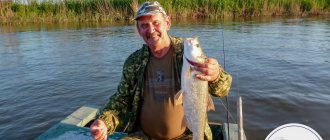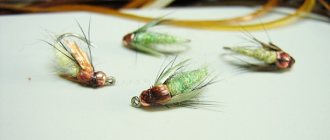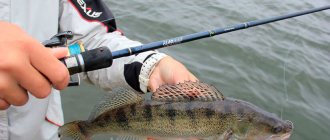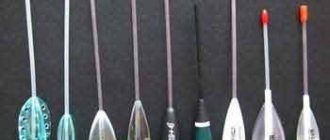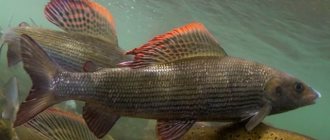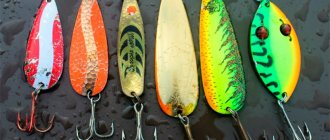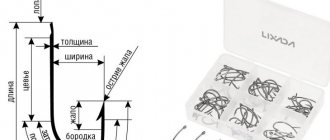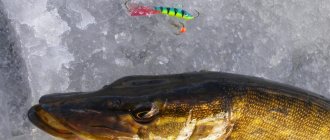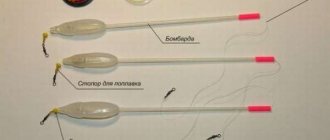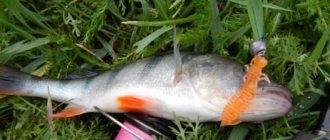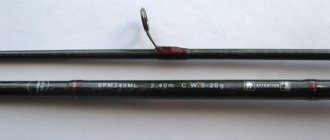Yuri 12/22/2020 538
There are different ways to catch predatory fish. In addition to the well-known ones, there are also those that few know about. Next, we will analyze in detail such gear as a bombard for perch. This fishing tackle is distinguished not only by its catchability, but also by its originality.
Let's talk about installation, features of its operation and nuances that any fisherman needs to know.
First, let's figure out what a fishing bombard is for catching river perch.
For perch with bombarda or sbirulino
At first glance, the idea of catching perch with a bombard seems far-fetched. There is a spinning rod, there is a long fly rod with light equipment, and finally, there is a match rod for “long casting” of live bait equipment. And yet, I believe that with the advent of night frosts, sbirulino can become the most effective tackle for catching schooling perch.
Seagulls over the asp “cauldron”. Photo: Andrey Yanshevsky.
Let's take the Volga reservoir as an example.
Perch leaves their summer camps on the edges, gathers in schools of their own kind in size and organizes a collective hunt for the grown fry. And he hunts not near the shore, but in the watering areas.
You can only get to the irrigation area by boat. Traditionally, in such places, perch is caught along with asp. There is an asp on top, and a perch under it. But when the asp’s exit was interrupted, the fish was alerted by the bustle of the surrounding fishermen and it quickly moved along the channel edge for several tens, or even hundreds of meters.
And the fisherman casts the bait for another twenty minutes, while wondering in which direction the flock moved. But you don’t have to chase the asp, but stay and catch the perch.
At first, the process goes well. Finally, after the fifth or tenth cast begins to bring small perches, the angler changes location.
It’s good if the asp starts beating again. What if the output is over for today? There are two options left: either stop fishing or look for a perch of decent size.
Perch is a schooling fish. Photo: Andrey Yanshevsky.
And then it becomes obvious that a different tackle is needed. The perch stops responding to the rapid movement of a heavy bait that imitates an escaping fingerling. We need more delicate bait and equipment.
You can replace the castmaster with a heavy spinner, which will significantly reduce the speed of wiring in the upper and middle layers of water, but another problem arises. The casting distance is significantly reduced. In order to find a school of perch that does not reveal itself as a fry, you need to change place after place.
Sbirulino or bombarda logically appears on the stage
Many people begin mastering the bombard as a fishing method by removing the lure and making a rig with a floating bombard weighing 15-30 g. About a meter below, two or even three white streamers made of wool or cambric are attached from an electric wire about five centimeters long.
This type of gear is effective and convenient when you find a school of fattening perch, for example, in the widening of the hole between the island and the main shore.
Fishing successfully lasts half an hour, the perch goes down and you need to either wait for it to rise again, or look for another point. Practice shows that it is better to wait. But I don’t want to wait, the excitement is taking its toll.
The best way out is to replace the floating bombard with a sinking one or a suspender with a certain movement horizon and continue fishing in the lower and even bottom layers of water with the same bait. But here it quickly becomes clear that the perch not only sank, but also shifted.
It is rarely possible to determine in which direction the fish has moved when the actual casting distance with a spinning rod is 30-40 m. One way or another, you will have to move. And the shorter the casting distance, the more often you will have to move.
Very quickly the conclusion crystallizes that a spinning rod is not the best option.
Tackle specialized for sbirulino allows you to almost double the fishing distance, which saves precious time on additional movements. It is also important that the fishing time increases significantly during a perch fight. There is no need to follow the flock if you can get to it.
I have had cases when I managed to position the boat in such a way that it was possible to refuse to move at all. I reached the fish with a long-range bombard along the entire closed route of movement of the perch chasing the fry. All fishing boiled down to waiting for the next exit, ten minutes of active fishing and again waiting for the exit. But this is an ideal, and therefore very rare, case.
Now let's move on to the gear itself. Many times I have held in my hands specialized fishing rods designed for sbirulino, but I have never had the opportunity to try them in action. The formation stopped them. It is classically parabolic, typical of rods designed for maximum long casting in calm conditions.
On a reservoir or on a river, as is known, in calm weather the fish are not very active in attacking the bait. It is good to fish when there is a fairly strong side wind and then, in addition to the range, casting accuracy is also required.
You need a “stick” that is not only fast, but also powerful enough. A bombard weighing 15 g turns out to be light in approximately half of the cases.
What comes to mind is not to take a spinning rod 3.3-3.6 m long, but rather a powerful enough rod for “long casting”.
The optimal test for such rods is, as a rule, up to 25-30 g. The construction of the blank is difficult and fast. This means that during casting, approximately the upper third of the rod works, and when fishing for large fish, the load is evenly distributed along the entire length of the blank.
If the fish is very large, then the maximum stresses are concentrated in the section at the junction of the handle and the back of the blank. This is the reason why the back of good rod models is additionally reinforced, which makes it possible to “blur” the critical section.
For many years I used match rods from the Scottish factory Daiwa for fishing with sbirulino, but from time to time the thought appeared that this was not correct. You need to make a separate tackle.
A tackle based on the Briscola Favilla telematch stick turned out to be a very good option.
For myself, I came to the conclusion that I am more comfortable using a reel with a front drag, size only 2500 in the Daiwa classification. In fact, there are now an abundance of very good and suitable reels on the market.
But, I want to focus on the fact that the operating conditions of the reel when fishing for sbirulino are difficult and products for a nickel do not last long.
A few words about the fishing line. I only use monofilament line designed for feeder fishing. It doesn’t really matter how sinking it is, the main thing is that it is perfectly calibrated to the third decimal place. Color doesn't matter. Diameter 0.145-0.185 mm.
I don’t have as many bombards themselves for different fishing conditions as I do floats or wobblers. I finally got rid of the cheap options, especially since they are all floating, and left only Cormoran and Colmic products.
The arsenal includes a whole range of floating, sinking and suspenders for guiding at a given depth, with a mass of 5 to 40 g.
To catch schooling active perch, I use a complex bait. If a perch chases a fry in a cauldron, then to the end of the fishing line I attach a small wobbler, for example, a Pontoon 21 Cheerful 34 SP MR suspender, and higher up at 40 and 80 cm are two homemade streamers made of goat hair.
Catching perch with a bombard on a microjig
Practical European fishermen have long mastered the use of bombards for perch and other fish, and enjoy the advantages of this fishing method when conventional jigs and migrojigs are ineffective. For example, a bombard allows you to create a very slow dive for a jig bait. And at the same time a decent casting range is ensured. Why is slow diving necessary when fishing for perch, and what role does casting distance play? Let's look at everything in order.
Why is the perch bombard effective?
Bombarda gives something that cannot be achieved with a simple microjig. It’s not a rare situation when dozens of twisters and vibrating tails are changed during a fishing trip, the most secret wiring is used and invented, but there are no perch bites. And as soon as you throw a bombard, it turns out that right off the coast there is a flock of humpback whales with a good appetite.
The fact is that the bombard sinks slowly, the bait, tied on a short leash, also hangs in the water column, and at the same time slightly moves its tail. An ordinary microjig head always sinks quickly, not attracting the attention of the fish enough. The particularly smooth movement of the bait, planning in the water column, which can only be achieved with a bombard, is often decisive.
Why use a bombard?
The bombard rig behaves predictably. As the speed of the bombard increases, no matter how sinking it is, it will float. And when the speed decreases, it will begin to slowly sink. This allows you to create effective retrieves, move the bait along the terrain, which is called tightly, and fish dumps.
The next significant point is the casting range. Too expensive a spinning rod, of course, makes it possible to achieve some progress in range, but still not as much as a cheap bombard. And perch, as you know, spends half of its “free” time away from the shores, swimming beyond the border of vegetation, lingering near the main channel. Therefore, many experienced anglers consider confident long casting to be half the battle when it comes to perch.
Attempts to slow down the movements of the bait with the help of a glider lead more to fruitless experiments in adjusting the tackle than to give a concrete result, and besides, then you will have to forget about the range.
It turns out that catching perch with a bombard is much more effective than fishing with a pure microjig.
Bombard fishing rod
With a regular microjig, a fast spinning rod is always used. But for bombarda, when fishing on a pond, a soft rod is better suited. Since high-quality long-distance casting with a fast action will not work, and a small perch will not bend such a stick, therefore the feeling of taking a trophy will be lost.
The conditions on the river are different, it is better to fish there with a monofilament line, then for controlling the bombard and for hooking, a fast action becomes simply necessary. And for the pond, we settle on a slow rod of the appropriate test, 2.7-3.0 meters long, which is not a problem at all. And then such a throwing stick needs to be equipped.
Equipment for catching perch with a bombard
First of all, you need to select a bombard. We are going to catch small and medium sized bass in the ponds. Therefore, a bombard weighing 10 16 grams is suitable for us. In terms of buoyancy, it is better to sink slowly, and in terms of design, it is transparent, made of plastic.
We also need to confidently manage the equipment. The bombard must be obedient. For example, bombards with a weighted lower part behave eccentrically, they strive to stand upright when reeling quickly, but then you will have to forget about normal wiring. Therefore, it is better to choose an unloaded bombard, even if it flies a little worse.
It is better to use braid. At the same time, there are no serious restrictions on the diameter, and the load is not small, and the spinning rod is soft and long. Therefore, when choosing a braid, you can save money by choosing a simpler and cheaper option, but with an increased diameter for a safety margin.
But it is better to choose a leash for catching perch from high-quality fluorocarbon. The diameter this time is between 0.15 and 0.18 mm. And the length of the leash is 1.0-1.5 meters. A pike leash clearly scares away the perch. It is advisable to place a noticeable coarse leash only when the pike really does not allow passage.
Scheme of the simplest equipment with a bombard
Lures when fishing with a bombard
The presence of a bombard creates its own requirements. A distinct play of the bait is required, with a very slow, even retrieve. First, you need to stock up on twisters and vibrating tails up to 4 cm long. And you need a compact jig head with a shortened hook, weighing up to 4 grams. A short hook is no less catchy, since the perch always swallows the bait deeply.
And the fact that the hook will be located only in the head part of the silicone makes the bait play freer and more noticeable when moving slowly.
Of course, the baits that can be used with a bombard are not limited to this, and the field of experimentation is very wide. But at the development stage, you shouldn’t constantly be busy sorting out baits, but it’s better to switch your attention to searching for schools of perch and examining the bottom.
Fishing tactics
The main advantage of using a bombard is the slow immersion of a silicone bait on a jig head with an attractive action. And you should try to demonstrate this trick to the perch more often. It is best to plan the bait down the slope. The cast should be made to the opposite shore, if width allows, or from a boat, and the bait should be brought from the shallows to the depths, not allowing it to drag along the bottom. As soon as we reach the edge, we immediately begin a smooth descent. As a rule, the perch takes it at this moment.
Catching perch with a bombard from installing gear to fishing in a pond
First of all, you should figure out what a bombard is and what other names this tackle has. Her second name is Sbirullino, so further we will use several names. This is a plastic, most often transparent, float filled with water, very similar to the well-known bulk float. Used when fishing with a spinning rod, allowing long casts.
The vast majority are used in conjunction with ultra-light and lightweight baits. These can be spinners, microjigs, spoons and other types of baits that perch loves. The idea is simple: the bombard gives the spinning rod versatility. Having a rod with a test weight higher than 10 grams makes it difficult to make long, accurate throws of light baits. Having equipped it with this kind of weight, you can begin installing gram gear and catch any perch over long distances.
Types of bombards
Since it is used in tandem with micro baits, it is worth remembering that they, in turn, differ in buoyancy methods.
The same applies to sbirulino, where the float corresponds to the tackle used. This condition is not mandatory, but is encouraged if you want to do everything according to the rules.
The varieties are similar to the types of wobblers, namely:
The names speak for themselves. When installing a floating type, it will be on the surface of the water, without going deep at all. Slow-sinking ones sink gradually, allowing the use of small perch spinners of medium depth. Sinking ones are perfect for fishing in the depths where a solitary striped humpback whale may be found. But how can the bombard be given additional weight or, conversely, get rid of it? Everything is very simple, it will depend on the method of loading your specific gear.
Divided into 2 types:
- Adjusting the weight by filling or draining the float. An excellent universal option that helps the fisherman change it right on the shore.
- The weight is built into the body of the bombard. In this case, it will not be possible to adjust it, so it is less universal. But knowing what baits you have in your fishing box, you can buy the right weight.
Note to the fisherman: the body of the float is made of plastic materials of different densities, therefore the same weight can be either fast sinking, floating or medium buoyant. Weight varies from 1-100 grams, covering absolutely the entire range of bait weights.
Varieties of bombard
A bombard for perch fishing is used in conjunction with small baits, which differ in the degree of buoyancy.
When using bombards, it will also be better if the floats correspond to the current gear.
Types of bombards:
- drowning;
- floating;
- slowly sinking.
Types of bombards
The floating type is not buried during use, but is located on the surface of the water. Slow-sinking ones are characterized by a gradual immersion under water, they allow the use of small spinners of medium depth, and sinking ones are advisable to use for fishing at depth.
The method of loading a particular gear influences whether there will be a need to increase or decrease the weight of the bombard.
There are 2 such methods:
- A simple universal method for independent use directly on the shore: drain or replenish the float with water, thereby adjusting its weight.
- The load is built into the tackle itself. You won’t be able to regulate it yourself, but if you have an idea of your baits, you can immediately purchase a suitable option.
- Note! The plastic used to make a bombard has different densities, so the same weight can turn out to be floating, sinking, or slowly sinking.
Spinning equipment
Installation is extremely simple and does not require serious skills or time. Sbirulino is threaded through the main fishing line, and a cambric or bead is placed below it. They are necessary to protect the following unit (when casting, the float will hit the unit with force, thereby reducing its quality; the rubber cambric absorbs the impact). Next, the main line is tied to a series of swivels connected to each other - this way the tackle does not twist or overlap when casting and fishing.
We mount a leash to the last swivel; its material does not matter, but it is advisable to have a carabiner at its second end. The carabiner will allow you to quickly and easily change the type of bait, for example, hang an offset with rubber, a wobbler or a spinner. The main message is that if the perch doesn’t bite at all, then you can always easily and quickly try to “lure” it to something else.
DIY bombard
To make it you will need: a piece of plexiglass, a metal frame, a pair of staples, an oven (hair dryer), a sharpening machine, a small drill (awl), tape and waterproof glue. The photo below shows the gear diagram and further actions.
We make a mold of the specified dimensions from metal for future gear
Side view of the metal form. Height in this case does not matter, the dimensions indicated in the photo above are important.
We cut out a blank from plexiglass that is larger than the mold.
Place the metal mold with the workpiece in a cabinet heated to 150 degrees. If you have a hair dryer, you can use it to heat and give plasticity to the plexiglass.
After the glass has heated up, become softer and sagged a little, we take the workpiece out of the oven. The presence of bubbles in the material indicates that the glass has overheated a little, but there is nothing to worry about.
We grind the edges on a whetstone until they reach metal.
We get the result as in the photo, the first half is ready.
We repeat all the above procedures to create a second, identical and symmetrical part.
We make small grooves on the surface of the float half (from the front and back). We place staples in these places.
We connect the two halves of our bombard together, having previously glued the seams with waterproof glue. Drill a hole using a small drill or awl. The hole is necessary to regulate the water level inside the gear
Fill the prepared tackle with water (the required amount) through a syringe. Cover the hole for filling with a small piece of tape. As practice has shown, this is enough.
Thank you for the article, this is the first time I’ve heard about this method. I'll have to try it in the spring.
Tackle and methods of fishing with bombard
It just so happens that finding information about the method of fishing with a bombard is quite simple - this can be done on the Internet or in fishing periodicals, but it is much more difficult to find an angler who uses this method in practice. In any case, I have never met such fishermen on any of the reservoirs of the Moscow region, nor on the reservoirs of other adjacent regions. More often than not, I had to deal with the puzzled looks of fellow hobbyists who tried in vain to understand what kind of tackle this is, on which there is a float, but no sinker, and instead of a traditional bait, the fish is offered something awkward.
My acquaintance with the bombarda happened a long time ago. Once I went to catch perch in one of the many quarries in the Tula region. According to a local resident, the depth in some places was more than five meters. That day the perch was clearly not in the mood and was occasionally tempted by a small twister on a lead. However, I noticed that quite often the perch bites occur a few seconds after the bait splashes down, which indicates that the perch is at half-water. Wiring in the thickness gave results, but the conclusion suggested itself - in this situation the turntable would be irreplaceable.
However, it was not possible to get the light spinner to the perch, and the large perch ignored it. The idea was already ripening in my head, and a couple of weeks later I stood on the bank of the quarry with new equipment: a slowly sinking bombard and a zero spinner on a one and a half meter leash. Half an hour of searching for the required wiring horizon - and the result was not long in coming. When I was photographing my catch, a local fisherman came up to me and told me that so many perches are usually caught here in a whole day, and it was only eleven in the morning. I said that perch is still being caught well, and when asked a reasonable question why I decided to stop fishing, I answered that in everything you need to know when to stop. He obviously liked my answer, and we started talking. My new acquaintance, as expected, heard about the bombard for the first time, and I hope that after our conversation his fishing horizons expanded a little.
It’s possible that the bombard would have remained just a sinker for me, helping to deliver the weightless spoon over the horizon, but, as usually happens, chance intervened. One fisherman I know, having learned that I was going to the Ryazan region for a few days to catch chub on an ultralight, said that he became interested in fly tying and successfully catches chub not only with fly fishing, but also with the help of a bombard. I won’t go into details, but it all ended with me being given several flies as a gift. On the advice of a friend, I bought a floating bombard at a nearby fishing store. All this simple belongings subsequently fit into a small pocket of the backpack. Who would have thought then that in the near future I would become a regular at fly fishing shops.
Features of fishing with a bomb and bait design
The bomb bait got its name because of the characteristic cloud of turbidity that it creates as it falls and hits the bottom. It is also called “bomb”, and this tackle also has the name “bulda” .
The principle of fishing consists of sharp swings of the rod, tension of the line and a pause.
Design of a fishing bomb . The design of a fishing bomb or “balda” consists of a cylindrical lead sinker and two “floating” hooks on the sides. The tackle may also have an additional hook on the main line, which, when the bait falls, smoothly falls behind it. Instead of a nozzle, the hooks are equipped with beads, and they are secured by a tight cambric clamped on the fore-end.
The perch is attracted by both the knocking on the bottom and the rising turbidity in which hooks with beads move, reminiscent of bloodworms and other larvae. Often, a caught perch has silt flowing out of its mouth, which indicates a greedy bite and an attack directly at the bottom.
The bomb bait rod has a hard whip that cuts through the fish and does not break when swung. At the end there is a nod in the form of a colored nipple. The thickness of the fishing line is not important and can reach up to 0.2 millimeters.
Advantages of the bomb bait:
– catchability; – quick detection of active perch; – catching large specimens; – fishing without bait.
A fishing rod with a “bomb” rig must be present in every bass fishing enthusiast’s fishing box . When the perch is active, fishing with a jig does not bring such good results, since it takes too much time to equip, deliver the bait to the bottom and retrieve it.
Video on bomb fishing:
Fishing with a bomb video
Catching perch with a bombard
Bombarda or sbirulino is a special float designed for spinning rods for long-distance casting. The bombard is equipped with its own weight - this is one of the elements of the float gear. With the help of the bombard, the spinning rod became an excellent rod for casting over light baits, despite the strong wind. In other words, these are sinkers that compensate for excess buoyancy if the equipment is light.
Sbirulino promotes migration near the top layer of water, in the middle of the reservoir and even along the surface of the bottom.
And a bombarda can weigh less than one gram. To choose a casting technique with a bombard, it is better to combine fly fishing (over the head) and mast techniques. This will prevent the leash from catching anything on the fly. Some fishermen use a retrieving technique that imitates the movements of a drowning insect (STOP and GO). A bombard can be cast over a distance of more than a hundred meters, despite its light weight.
- Bombard floats are divided according to their buoyancy:
- a floating bombard that does not sink;
- medium-floating, sinking at a slow pace;
- drowning in water.
When using a floating bombard, fishermen cast the bait on the topmost layer of water, while a sinking bombard allows the bait to sink to the bottom.
Bombard loading and its types:
built-in lead weight inside the float;
bombard with a cavity for filling it with water during fishing.
These types differ from each other, perhaps, only in design.
Tackle
It is better to choose a longer rod, from 4 to six meters. The bending pattern of the rod should be parabolic (slow). This allows you to throw a heavy bombard far. The weight of the bombard is not higher than the test value, fifty grams is the best option.
The reel used is an ordinary one without inertia, the clutch is adjusted. The bobbin capacity is 0.25 per hundred meters of line.
It is best to use braided fishing line. They are usually caught with a bite on the tip of the fishing rod and must be hooked instantly. The “braid” will not stretch if you stretch it. Monofilament will work too.
The bombard can be used in different sizes, it depends on what casting distance you choose. For example, 40 gram floats work great.
For the leash, fluorocarbon leader line is used. Such a fishing line will be invisible in the water column. The length of the leash is 1.5 - 3.2 m. This is a necessary measure, because the bombard can scare the fish, and therefore it must swim at a distance from the bait.
If you choose to fish with natural bait, then the hook must be selected according to the size of the fish so that it can fit in the mouth.
Since flies and similar baits often twist the line quite strongly, it is better to use triple swivels.
Catching perch with a bombard rig
There are a large number of rigs with a bombard: with many hooks before and after sbirulino. We offer a classic one, which is easy to fit with many hooks.
How to mount a bombard
We put a bombard on the main line.
Then there is a rubber stopper that prevents the heavy bombard from hitting the knot that attaches the carbines to the forest.
The next stage of installation, which does not allow crazy twisting of the line, is fastening the finished chain of 3 swivels without using fasteners.
Then - a 1.5-meter or 3-meter leash, options are possible.
At the end, a bait in the form of a fly or similar is attached. You can use a hook with maggots, worms, corn and other natural bait.
Lures used for bombard rigs
- front sight;
- small twister, vibrotail, foam fish;
- foam ball; surface wobbler;
- all attachments of animal and plant origin.
When fishing with a bombard, bait is not always appropriate, but in order to collect white fish in one place, bait will be necessary. If there is a current, then there should be clay in the bait: it will prevent the bait balls from being carried away by the current. The wiring should be very slow and even.
Second step: retrieving with the end of the rod moving three meters, returning to the starting place, the reel is reeled in, the bait does not move. Then - leisurely wiring with twitching.
How often and how far you need to twitch - this experience is acquired in the process of fishing. When fishing, the bait should create a good game; if this does not happen, you need to increase the speed. You can also improve the twister tail by making it a little lighter. The bombard float began to be used relatively recently, and is not particularly popular. But the bombard has no disadvantages, and there are more than enough advantages!
Fishing Features
You can catch trout using a bombard using both artificial and natural baits. The entire range of attachments offered by specialized stores will be suitable. Sbirulino should be selected taking into account the fact that the bait will need to be placed near the surface of the bottom or in the water column. This method is extremely convenient, because you can search for fish at absolutely any depth. A quick change of bombard varieties will allow you to figure out exactly where the fish are and immediately start fishing.
To catch an asp, you should use a long leash to bring the bait to greater depths. When encountering riffles, it will be quite convenient to avoid obstacles. It is recommended to choose a bait less than the weight of the bombard. The choice of equipment depends on the fishing location.
Casting is done vertically, smoothly and very carefully. A turbine, which should move along the surface using a float, is ideal as bait. The impeller will allow you to make the best casts with good speed and prevent the leader from twisting. The asp is a very cautious fish, so fishing is sure to be exciting. The fish are brought to land mostly with minimal damage.
For bleak, you should feed the fishing area well. If you want to catch larger specimens of bleak, you need to send the bait away from the shoreline using a slingshot to supply feed. On cool days, the fish almost sink to the bottom. However, the bait spends most of its time almost at the surface of the water, without falling below a meter, so the bait should be offered floating on the surface.
Suitable baits include maggots, nanotwisters, small flies and edible plastic. To increase the bite, it is recommended to use various flavors.
You can read the instructions in our article on how to make a fly with your own hands.
Perch on a bombard will also bring an excellent catch if you choose the right time and bait. Early in the morning at dawn and from sunset to darkness, the bite is confident and frequent. Small spinners, vibrator tails, worms and twisters make excellent bait.
When catching a chub, the bombard should be on the surface. There is a good bite both on the rifts and in still water. On wide bodies of water, it is necessary to use uniform wiring, and cast at an angle to the direction of the flow. The game will be interesting for the fish by simply floating the bait along the surface with a slight twitch of the rod tip.
The chub is famous for its powerful jerks, which easily break the fishing line. That is why it is better not to save on reels, but to choose a high-quality spinning reel with a well-adjustable clutch.
Summer fishing for sabrefish brings a dizzying bite using a bombard. Rather slow wiring is used, sometimes diluted with short jerks. In an hour of fishing with sbirulino you can catch up to five kilograms of fish. A variety of attachments are used: mastyrka, pearl barley, white twisters, maggots and dung worms.
The main catch for the bombard is, of course, pike. However, catching a predator is quite difficult. Sometimes the fish will not bite on anything other than the bombarda, and there are days when the sbirulino does not give any signs of a bite. Therefore, when coming to a pond, you should experiment to understand what the fish wants at the moment. The most interesting thing is that the pike is mainly initially attracted to the bombard itself, and when it comes closer to it, it receives an additional bonus - bait.
Proper bombard rig and rod selection
No self-respecting fisherman will miss the opportunity to get acquainted and further practical use of this interesting method of equipment. Such a tempting and mysterious abbreviation attracts the fisherman with its sound and inspires him with hope for solid catches, which, by the way, are not empty words that have a real basis.
Of course, not everyone who tries the equipment in action later becomes its ardent fan. But everyone will agree that a bombard for fishing is a spectacular and effective element. And this is not a tribute to fashion, but a modern approach, where there is a reason to use productive and progressive equipment.
What is a bombard?
Fishing with a bombard is a type of equipment that allows you to catch a variety of fish, the main element of which is a float in the form of a miniature egg, strung along its axis on a small diameter tube. The main role of this float is to ensure the casting range of small bait, as well as control the level of depth of the thrown bait during the process of retrieving it.
For general development and to exclude double assessments, I can say with confidence that the name of the bombard float, which has become more familiar to us, is quite identical to the word sbirulino. Therefore, there is no need to look for differences in equipment, since it is absolutely the same equipment. This float is made of dense plastic and its colors can vary from transparent specimens to options with exotic colors, for example, acidic or black with a metallic tint.
Catching chub with a bombard
The methods and techniques of fishing with a bombard with a fly depend on the body of water and the float. The wiring depends on this.
Let's take a look at the angler's recommendations for catching chub with a bombard using the cockchafer.
Lures for chub
The chub is an omnivorous fish. It feeds on both animal organisms and vegetation .
Therefore, various baits are used to catch it:
- flies;
- foam baits;
- wobblers;
- baits made of silicone material;
- small spoons;
- baits imitating beetles;
- worms;
- insects;
- tadpoles;
- vegetable attachments (mastyrka, bread, dough, peas, corn, cereals).
Rod selection
As with any other common type of fishing, there is specialized equipment for their conditions. In nature, fishing gear also includes a bombard rod. Manufacturers of gear endow it with certain qualities that provide comfort and reliability when fishing with a bombard. In general, such a rod can be described as a soft rod of parabolic action, measuring from three to six meters with a test in the range of 25–60 grams.
But these characteristics of the gear do not mean that its other technical potential cannot be used with a float. A spinning rod for a slow action bombard is an ideal example of this. The telescopic rods of the above test frames can also serve as an excellent example. Match gear adapted for sbirulino also sufficiently provides the possibilities for this fishing method.
Bombard equipment
Bombard fishing tackle has its own classic rigging algorithm, which varies by replacing the floats, the length of the leashes and the type of bait. The classic is to equip the tackle with a medium-sized spinning reel with a friction gear designed for spinning fishing for predatory fish. The reel is equipped with monofilament or braided cord, depending on who you like, because this factor will not have a decisive significance on the quality of fishing with a slow rod action, with a thickness of 0.2 to 0.3 mm and a volume of at least one hundred meters. A bombard is strung on a cord. Its movement up the line is limited by a stopper. A meter and a half, or even a meter, is quite a sufficient distance.
Next, a block of swivels is tied to the fishing line; three or five in a row completely satisfy the conditions that prevent the main thread from twisting. It is mandatory to place a damper bead made of strong material in front of the knot. The float, with each cast, will necessarily and with considerable effort repulse its inertial mass from it. At the end of the swivel block, the installation ends with a clasp to which leashes with baits will be attached.
Important! Various types of baits can serve as bait, ranging from animals to a variety of artificial ones.
Depending on the type of fish, worms, maggots, pearl barley, mastyrka are used, and, of course, wobblers, spinners of various designs, and artificial flies are an integral part of this bombard fishing subculture.
Fishing with a bombard fly involves the use of floating floats. Chub, rudd and saberfish become the main objects of hunting with such equipment. Bombard fishing for asp, perch, trout, bream and pike requires the use of slowly sinking floats. Fast-sinking representatives of the bombarda are used for catching bottom fish, such as catfish and, to a greater extent, pike perch.
Important! The length of the leash depends on the timidity and caution of the fish.
Pike are not afraid of the float and even make attacks when it moves, so when catching it, a thin metal leash of 30 cm will be enough. Often, focusing purely on pike fishing, anglers additionally equip the bombard itself with a suspended tee, and not without success. Wary and suspicious trout need leashes of one and a half meters, which is why six-meter rods are not uncommon in bombard fishing, because it is in principle impossible to cast such long rigs with a shorter rod.
Equipment
When fishing with sbirulino, or bombarda, you can’t get by with a simple fishing rod or spinning rod, so they use special equipment. The design includes a leash from 1 to 1.5 m for bottom fishing. In this case, the length of the rod must be 3 meters or more. This type of fishing also requires the presence of a fishing reel and fishing line, which cannot be seen underwater.
Assembling fishing gear with a bombard is quite easy. The float itself is attached to the fishing line, after which a stopper is installed, followed by a swivel, which should prevent twisting. Then a leash is placed, the length of which is no more than 1 m, and the bait is installed. There are some other rules regarding snap-ins:
- The bait is attached to the bombard using a thickening.
- Between the sbirulino and the swivels you need to place a bead, which will serve as protection for the fishing knot.
- To prevent line bleeding, a lock must be installed between the float and the rod.
For such fishing, you can use both live (worms, leeches, beetles, etc.) and artificial (silicone slaves, spoons, foam balls, etc.) baits.
How to fish with a bombard
The range and accuracy of delivery of small baits allows you to fish large areas of water by casting the equipment from one point.
Important! Having identified a promising place, you need to throw it and pause to allow the bait to reach the desired depth level. When the float brought to the required horizon is stabilized, wiring begins.
Postings with bait stops, like jigs, twitching movements with a rod, tossing of equipment, ordinary wiring by winding the cord - everything is acceptable when using bombard fishing tackle. Improvisations with pauses irritate perch, pike and pike perch. The monotony of the wiring tempts rudd, bream and catfish to bite.
Hanging the bait in the water column perfectly attracts the picky and seemingly completely elusive asp to bite. Stepped wiring is the king of techniques when hunting for trout representatives of reservoirs. Fly fishing with a bombard is similar to the fly fishing technique. Having mastered this direction, your catches will include chub, grayling and saberfish as regular trophies.
How to catch
Sbirulino is used for fishing with lures of different types, shapes and sizes. Make smooth and slow retrieves, twitch the end of the spinning rod and tighten the line. The moment of bite is easily felt due to the soft design, since the fishing line passes through the float tube.
The EC float allows you to use a fly as bait. You can explore large areas of the water area while standing in one place. After casting, you need to wait a little for the bait to drop to the set depth and then make the retrieve.
Improvised movements of the rod attract different fish. Depending on the situation, the following actions are appropriate:
- pull-ups with short pauses;
- monotonous wiring;
- throwing the equipment up;
- small twitches;
- "trembling" of the fishing line.
For long casts, you will have to practice a little, and then choose which option is most suitable: over the head or from the side, fly fishing or “mast” cast. To prevent the float from getting tangled when it falls on the water, you need to hold the line a little.
Bombards, which sink slowly, are suitable for any thickness of water and long distances; surface sbirulinos allow you to catch perch and pike within a radius of 0.5 m.
Advantages of gear
The main advantages of fishing with this method include, as has already been mentioned more than once in the article, the possibility of delivering small and light bait to a considerable distance from the casting point. By varying the mass of the float in combination with baits of various types, delivering the equipment to the hundred-meter mark is a realistically achievable goal.
The advantages of such a cast are obvious; cautious fish that ignore the proximity of the shore can actually be provoked to bite. An important advantage of this type of equipment is the possibility of finer control of the level of the horizon of the bait in the water column. With other fishing methods, in particular spinning, such fishing can only be carried out by a fairly experienced angler.
When fishing with a bombard, having selected the desired type of float, including the standard size and weight, almost any angler will perform such manipulations at the required fishing horizon. This method also solves the problem of delivering small baits to depths that are prohibitive for them. For example, a suspended wobbler of three or five grams, a sinking float with a short leash, can actually press it to the bottom of the reservoir, causing a bottom predator to bite.
A do-it-yourself bombard is not an advantage if a fisherman can make such a device from improvised and cheap materials. But more specifically about this, in the chapter below.
Tackle components
A rod for fishing with sbirulino will need to have the following characteristics:
- The length of the form is about 4 meters and it is quite natural that it will be a telescope. A long rod will allow you to make the longest and most accurate casts, and will also make it easier to control the movement of the tackle.
- The presence of a slow or medium build.
- The tip of a rod for bombard fishing should be incredibly sensitive even to uncertain bites from small fish.
- It is necessary to have a large number of throughput rings. This will give sensitivity to the tackle when retrieving.
When choosing a reel, it is not recommended to choose the cheapest options. Experts advise choosing a spinning one with a size of 2000 - 2500.
The fishing line is either thin braid or fluorocarbon with a diameter of 0.18 mm to 0.25 mm. Fine tuning of the clutch and fairly good flexibility of the rod compensate, if necessary, for some weakness of the fishing line. When fighting a trophy specimen of a predator, there will be a real chance of winning.
Bombarda comes in light, medium and heavy weights. The most convenient are medium ones, weighing 11–15 grams. It is recommended to choose transparent plastic based on color so as not to scare away the fish in the fishing area. This applies to all bombards located at depth, but floating ones are better to choose a bright color for ease of control. Good variegated sbirulino is produced under the Cormoran and DAM brands.
When wiring, the equipment tends to rotate and sometimes twist, so it is worth purchasing exclusively triple swivels of a wide variety of designs. The leash can be made from reliable transparent monofilament. The length of the leash should be 3 meters. We tie the bait to both long and short leashes, which will help diversify the game and successfully attract the attention of the fish. However, it is worth noting that when casting, short leashes can get tangled.
A wide range of baits are used for fishing:
- Flies.
- Grasshoppers.
- Worms.
- Streamers.
- Front sights.
- Mini turntables.
- Wobblers of miniature sizes.
- Very small twisters.
How to make a bombard
There is nothing complicated in the options; you can make this wonderful float yourself. A homemade bombard, with proper balancing of the main body of the float on the rod, will not differ in any way from the qualities of its factory counterpart. As the main body of the float, you can use foam blanks, polished to the desired shape and with weights mounted inside.
Old floats with broken antennas for float fishing are also do-it-yourself bombards. By drilling a hole and placing the body of the future bombard on a hollow rod that has a certain mass balanced with the float, you will get a floating representative of the equipment. But the proposal from a disposable syringe claims to be a really accurate version of a bombard for loading at the fishing site. Having shown imagination and a little effort, and subsequently received results in the form of successful bites, the fisherman who has made this modern attribute of equipment can rightfully be proud of his resourcefulness and skills.
Sources:
https://www.ohotniki.ru/fishing/method/article/2017/10/02/649418-za-okunem-s-bombardoy-ili-sbirulino.html https://lykistreli.ru/lovlya-okunya-na -bombardu.html https://www.prospinning.ru/tekhnika-i-taktika/554-snasti-i-metody-lovli-na-bombardu-golavlya-okunya-primanki-mushki.html https://karppoklevkin.ru /435-lovlja-okunja-na-bombardu.html https://iarybak.ru/snasti/bombarda-dlya-rybalki
